The Laocon exhibition in the Vatican Museums.
It is difficult quite to appreciate today the excitement in Rome, and soon in the whole of Europe, when, on 14 January 1506, Felice de Fredi came across the sculptural group known as the Laocon in his vineyard by the Terme di Tito, near the Colosseum. On hearing of the event, Pope Julius II sent his chief architect, Giuliano da Sangallo, together with Michelangelo, who immediately identified the exceptional piece as that described by Pliny the Elder and attributed by him to the sculptors Agesander, Athenadoros and Polydoros of Rhodes. After brief negotiations, the piece entered the papal collection and has been one of the most famous and influential works of art in the world ever since.
There are various versions of the legend of Laocon, but the best known is that by Vergil (Aeneid ii, 109 et seq.), in which the Trojan priest, having inveighed against the wooden horse left behind by the Greeks, was killed, together with his sons, by two serpents sent from the sea by Athena, alarmed that the Trojans would not take the horse into the city. His discourse ends with words that have become proverbial; timeo Danaos et dona ferentes I fear the Greeks, even when, and particularly when, they bear gifts.
The admirable, fascinating and concise exhibition put on within the Vatican Museums to celebrate the 500th anniversary of the works discovery is divided into four sections: (1) Laocon and Laocons, in which the visitor can view books and works of art which depict the legend, not necessarily exactly the same version as Vergils: (2) the discovery of the piece, with the Vaticans Laocon sculpture itself, the head of Ulysses from Tiberiuss grotto at Sperlonga, probably by the same sculptors, and other relevant pieces: (3) the works fortune, with examples of works inspired by the group, such as the bronze version made in 1540 by Primaticcio for Franois I to be diplayed at Fontainebleau, and various sketches, prints, decorative items and photos: (4) Laocon for ever, or contemporary works of art inspired by the sculpture.
Amongst the various exhibits, in addition to those already mentioned, the following are of quite exceptional interest:
The plaster cast made by Filippo Magi in 1957 of the various pieces which go together to form the whole group. Magi was responsible for the restoration of the scuplture and the reattaching of the original right arm, which had always been missing and was spotted in 1905 by the American archaeologist, Ludwig Pollak in an antique shop in Via Labicana. This is really fascinating.
15th-century manuscript of Vergil, with illustrations of the sons being strangled by the snakes.
Facsimile of the fourth/fifth-century works of Vergil, a very famous manuscript known to Raphael and his circle, amongst others.
Extraordinary portrait of Michelangelo in black and red chalk by Fra Bartolomeo (Bartolomeo di Paolo), from the Museum Boynings-van Benningen in Rotterdam.
Exquisitely lettered 16th-century manuscript of a poem by Evangelista Maddaleni deCapodiferro celebrating the discovery itself.
Raphaels sketch from Windsor castle of three heads, preparatory for the Parnassus in the Stanza della Segnatura, in which the head of Homer is clearly inspired by the head of Laocon.
Two chalk studies by Rubens of the sculpture.
Berninis head of Laocon from the Palazzo Spada.
Preparatory design for a Svres vase, on which were illustrated the triumphal arrival in Paris of many of the treasures awarded to Napoleon under the Treaty of Tolentino of 1797, including the Laocon and the Apollo del Belvedere.
One surprising error in an exhibition which has clearly been prepared with the utmost care; the texts which accompany the two works by Bernini on display, the head from Palazzo Spada and a study of the torso, give the artists dates as being 1592-1680, when in fact they are 1598-1680.
Entry to the exhibition is free and via the normal entrance to the Museums. It will remain open until 28 February 2007. Mon-Fri 8.45-12.20, 13.00-16.45, Sat 8.45-12.20. Sun closed except (the last Sunday of each month). Also closed 8 and 25 December, 1 and 6 January and 11 February.


















